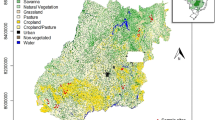Abstract
While there has been much focus in biodiversity conservation that transcends place, few studies transcend time. Yet an appreciation of vegetational and hydrological succession is essential for maintaining a habitat that has been created with the aim of conserving a particular group of organisms. This is a study of changes in a dragonfly assemblage over a period of 13 years at a biodiversity-rich, southern hemisphere reservoir. A total of 30 dragonfly species were recorded in this study, compared to 12 species before the reservoir was constructed in 1988, and 26 species in 1993, with 25 species resident in both 1993 and 2001. Two of these are local endemics. One other endemic was lost to succession in 1993 but reappeared in 2001. Three other species never reappeared after succession in 1993, yet six other species appeared after this date. Multivariate analyses identified structural and compositional vegetation, especially marginal forest, percentage vegetation cover, percentage shade, as the most important environmental variables determining dragonfly species composition. Other important environmental variables were grasses of tall, medium and short height categories, submerged vegetation, water flow and amount of open water. Not surprisingly, successional changes in vegetation physiognomy and in water conditions significantly increased Odonata species richness and diversity over the years. More importantly, the study shows that to maintain both high species richness, including endemics, it is essential to maintain a variety of biotopes using selective management of the marginal vegetation without allowing succession to proceed to a point where overgrowth of the bank and silting of the bottom begin to impoverish the fauna.
Similar content being viewed by others
References
Askew R.R. 1982. Resting and roosting site-selection by coenagrionid damselflies. Advances in Odonatology 1: 1–8.
Buchwald R. 1992. Vegetation and dragonfly fauna - characteristics and examples of biocenological field studies. Vegetation 101: 99–107.
Chelmick D., Hammond C., Moore N.W. and Stubbs A. 1980. The Conservation of Dragonflies. Nature Conservancy Council, Peterborough, UK.
Chovanec A. 1994. Man-made wetlands in urban recreational areas - a habitat for endangered species? Landscape and Urban Planning 29: 43–54.
Chovanec A. and Raab R. 1997. Dragonflies (Insect, Odonata) and the ecological status of newly created wetlands - examples for long-term bio-indication programmes. Limnologica 27: 381–392.
Clark K.R. and Warwick R.M. 1994. Changes in Marine Communities: An Approach to Statistical Analysis and Interpretation. Plymouth Marine Laboratory, UK.
Corbet P.S. 1999. Dragonflies: Behaviour and Ecology of Odonata. Harley Books, Colchester, Essex, UK.
Kinvig R.G. and Samways M.J. 2000. Conserving dragonflies (Odonata) along streams running through commercial forestry. Odonatologica 29: 195–294.
Ludwig J.A. and Reynolds J.F. 1988. Statistical Ecology: A Primer on Methods and Computing. Wiley, New York.
Moore N.W. 1991. The development of dragonfly communities and the consequences of territorial behaviour: a 27-year study on small ponds at Woodwalten Fen, Cambridgeshire, UK. Odonatologica 20: 203–231.
Moore N.W. 2001. Changes in the dragonfly communities at the twenty ponds at Woodwalton Fen, Cambridgeshire, United Kingdom, since the study of 1962–1988. Odonatologica 30: 289–298.
Osborn R. and Samways M.J. 1996. Determinants of adult assemblage patterns at new ponds in South Africa. Odonatologica 25: 49–58.
Primack R., Kobori H. and Mori S. 2000. Dragonfly pond restoration promotes conservation awareness in Japan. Conservation Biology 14: 1553–1554.
Samways M.J. 1989. Farm dams as nature reserves for dragonflies (Odonata) at various altitudes in the Natal Drakensburg mountains, South Africa. Biological Conservation 48: 181–187.
Samways M.J. 1992. Dragonfly conservation in South Africa: a biogeographical perspective. Odonatologica 21: 165–180
Samways M.J. 1993. Dragonflies (Odonata) in taxic overlays and biodiversity conservation. In: Gaston K.J., New T.R. and Samways M.J. (eds) Perspectives on Insect Conservation. Intercept, Andover, UK, pp. 111–123.
Samways M.J. 1999. Diversity and conservation status of South African dragonflies (Odonata). Odonatologica 28: 1–116.
Samways M.J. and Steytler N.S. 1996. Dragonfly (Odonata) distribution patterns in urban and forest landscapes and recommendations for riparian corridor management. Biological Conservation 78: 279–288.
Samways M.J., Caldwell P.M. and Osborn R. 1996. Spatial patterns of dragonflies (Odonata) as indicators for design of a conservation pond. Odonatologica 25: 157–166.
Schmidt E. 1985. Habitat inventorization, characterisation and bio-indication by a “Representative Spectrum of Odonata species (RSO)”. Odonatologica 14: 127–133.
Sternberg K. 1994. Niche specialisation in dragonflies. Advances in Odonatology 6: 177–198.
Steytler N.S. 1993. Habitat fidelity of adult male dragonflies and damselflies (Odonata) at an artificially created lake providing for insect conservation in a botanical garden in Natal. Unpublished Honours Thesis, University of Natal, South Africa.
Steytler N.S. and Samways M.J. 1995. Biotope selection by adult male dragonflies (Odonata) at an artificial lake created for insect conservation in South Africa. Biological Conservation 72: 381–386.
Suh A.N. and Samways M.J. 2001. Development of a dragonfly awareness trail in an African botanical garden. Biological Conservation 100: 345–353.
Ter Braak C.J.F. 1986. Canonical correspondence analysis: a new eigenvector technique for multivariate direct gradient analysis. Ecology 67: 1167–1179.
Ter Braak C.J.F. 1987. Unimodal models to relate species to environment. Agricultural Mathematics Group, Wageningen, The Netherlands.
Watson J.A.L., Arthington A.H. and Conrick D.L. 1982. Effect of sewage effluent on dragonflies (Odonata) of Bulimba Creek, Brisbane. Australian Journal of Freshwater Research 33: 517–528.
Author information
Authors and Affiliations
Corresponding author
Rights and permissions
About this article
Cite this article
Suh, A.N., Samways, M.J. Significance of temporal changes when designing a reservoir for conservation of dragonfly diversity. Biodivers Conserv 14, 165–178 (2005). https://doi.org/10.1007/s10531-005-3652-5
Received:
Accepted:
Issue Date:
DOI: https://doi.org/10.1007/s10531-005-3652-5




